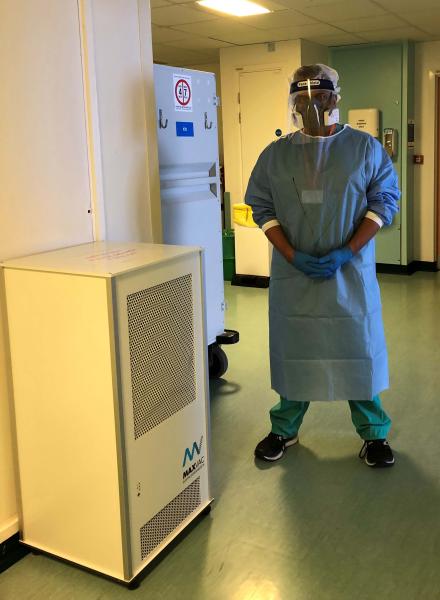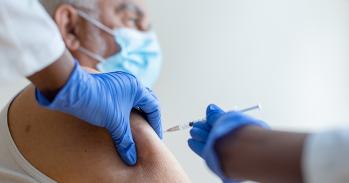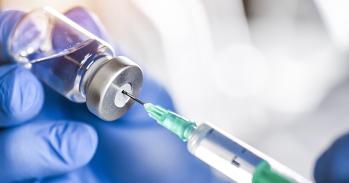
When a team of doctors, scientists and engineers at Addenbrooke’s Hospital and the University of Cambridge placed an air filtration machine in COVID-19 wards, they found that it removed almost all traces of airborne SARS-CoV-2.
When a team of doctors, scientists and engineers at Addenbrooke’s Hospital and the University of Cambridge placed an air filtration machine in COVID-19 wards, they found that it removed almost all traces of airborne SARS-CoV-2.
Reducing airborne transmission of the coronavirus is extremely important for the safety of both patients and staff
Vilas Navapurkar
While the discovery could have implications for improving the safety of repurposed ‘surge wards’, the researchers say it also opens up the possibility of being able to set standards for cleaner air to reduce the risk of airborne transmission of infections.
Over the duration of the pandemic there has been a steady rise in the evidence that the SARS-CoV-2 virus can be transmitted through the air in small droplets (aerosols). But as hospitals have seen their capacity overwhelmed, they have been forced to manage many of their COVID-19 patients in repurposed ‘surge’ wards, which often lack the ability to change the air with a high frequency. While the use of appropriate personal protective equipment (PPE) protects staff and patients significantly reduces the risk of transmission, there are still reports of patient-to-healthcare worker transmission of the virus, potentially through the inhalation of viral particles.
A team at the University of Cambridge and Cambridge University Hospitals (CUH) NHS Foundation Trust investigated whether portable air filtration/UV sterilisation devices could reduce airborne SARS- CoV-2 in general wards that had been repurposed as a COVID ward and a COVID Intensive Care Unit (ICU). The results are published in Clinical Infectious Diseases.
Dr Vilas Navapurkar, a Consultant in Intensive Care Medicine at CUH, who led the study, said: “Reducing airborne transmission of the coronavirus is extremely important for the safety of both patients and staff. Effective PPE has made a huge difference, but anything we can do to reduce the risk further is important.”
“Because of the numbers of patients being admitted with COVID-19, hospitals have had to use wards not designed for managing respiratory infections. During an intensely busy time, we were able to pull together a team from across the hospital and University to test whether portable air filtration devices, which are relatively inexpensive, might remove airborne SARS-CoV-2 and make these wards safer.”
The team performed their study in two repurposed COVID-19 units in Addenbrooke’s Hospital. One area was a surge ward managing patients who required simple oxygen treatment or no respiratory support; the second was a surge ICU managing patients who required ventilation either through non-invasive mask ventilation or invasive respiratory support, such as involving the use of an invasive tube and tracheostomy.
The team installed a High Efficiency Particulate Air (HEPA) air filter/UV steriliser. HEPA filters are made up of thousands of fibres knitted together to form a material that filters out particles above a certain size. The machines were placed in fixed positions and operated continuously for seven days, filtering the full volume of air in each room between five and ten times per hour.
In the surge ward, during the first week prior to the air filter being activated, the researchers were able to detect SARS-CoV-2 on all sampling days. Once the air filter was switched on and run continuously, the team were unable to detect SARS-CoV-2 on any of the five testing days. They then switched off the machine and repeated the sampling – once again, they were able to detect SARS-CoV-2 on three of the five sampling days.
On the ICU, the team found limited evidence of airborne SARS-CoV-2 in the weeks when the machine was switched off and traces of the virus on one sampling day when the machine was active.
Additionally, the air filters significantly reduced levels of bacterial, fungal and other viral bioaerosols on the both the surge ward and the ICU, highlighting an added benefit of the system.

First author Dr Andrew Conway Morris, from the Department of Medicine at the University of Cambridge, said: “We were really surprised by quite how effect air filters were at removing airborne SARS-CoV-2 on the wards. Although it was only a small study, it highlights their potential to improve the safety of wards, particularly in areas not designed for managing highly infectious diseases such as COVID-19.”
Crucially, the research team developed a robust technique for assessing the quality of air, involving placing air samplers at various points in the room and then testing the samples using PCR assays similar those used in the ‘gold standard’ COVID-19 tests.
Professor Stephen Baker, from the Cambridge Institute of Therapeutic Immunology and Infectious Disease at the University of Cambridge, said: “Cleaner air will reduce the risk of airborne disease transmission, but it’s unlikely to be the case that just installing an air filter will be enough to guarantee the air is clean enough. Every room and every situation will be different. A key part of our work has been developing a robust way of measuring air quality.”
Dr Navapurkar added: “We’re all familiar with the idea of having standards for clean water and of hygiene standards for food. We need now to agree standards for what is acceptable air quality and how we meet and monitor those standards.”
The research was supported by Wellcome, the Medical Research Council and the National Institute for Health Research Cambridge Biomedical Research Centre.
Reference
Conway Morris, A, et al. The removal of airborne SARS-CoV-2 and other microbial bioaerosols by air filtration on COVID-19 surge units. Clin Inf Dis; 30 Oct 2021; DOI: 10.1093/cid/ciab933
Image: Dr Vilas Navapurkar in ICU beside an air filter

The text in this work is licensed under a Creative Commons Attribution 4.0 International License. Images, including our videos, are Copyright ©University of Cambridge and licensors/contributors as identified. All rights reserved. We make our image and video content available in a number of ways – as here, on our main website under its Terms and conditions, and on a range of channels including social media that permit your use and sharing of our content under their respective Terms.




